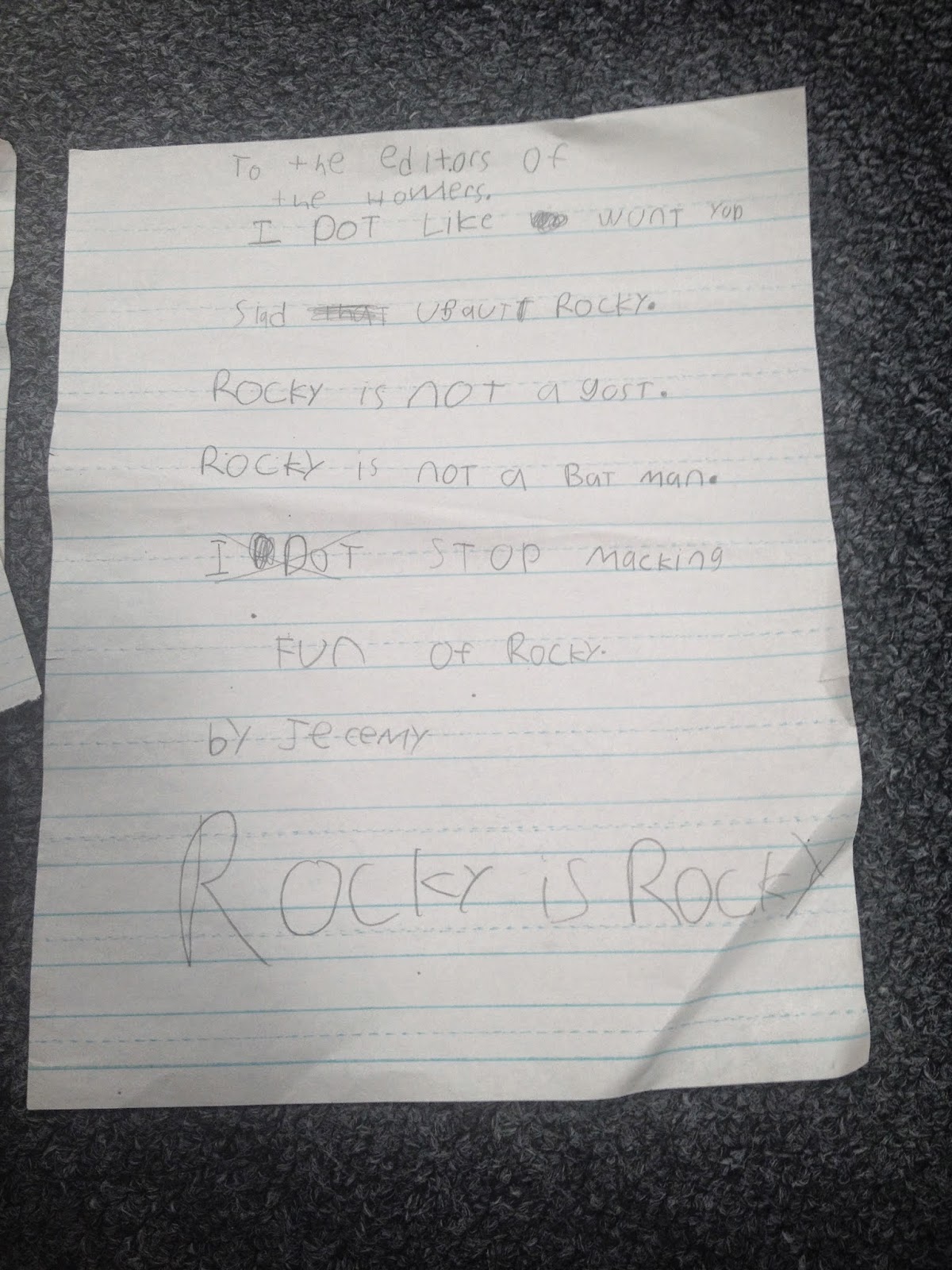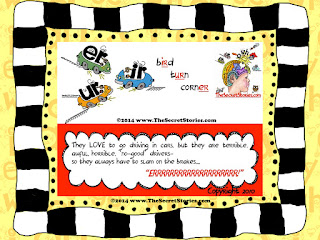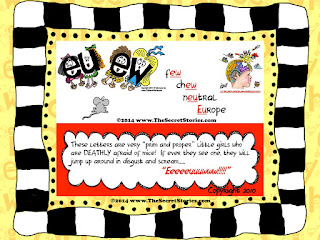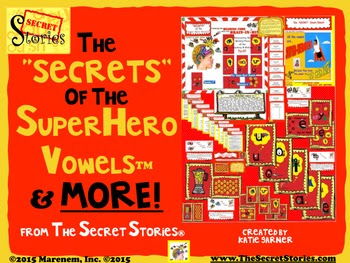"First Graders Offended By School News Article!"
I'm excited to share this second post by Mrs. McAnulty about the "unexpected consequences" of having taught the Secrets to her first grade class!
"First Graders Offended By School News Article!"
An Exercise in Persuasive Writing
By Renee McAnulty & Her 1st Grade Munchkins
Well, if there is one thing I have learned in my years of teaching, it's that great teachers improvise. So I calmed my panicked babies and told them I had something incredibly special for them to read during "Read to Self" and "Read to Someone" and that they were going to flip out.
So they began high-fiving each other and shouting cheers of joy and celebration while I frantically searched around the classroom for something, anything, that they could read... they didn't know that I was winging it... there had to be something they could read that was still in the classroom.
Then I spotted it, shining down from the heavens above… a stack of hot-off-the-press school newspapers. “The Howler! It's perfect," I thought. "They can read this. They will love it!" So I gasped loudly so my students sensed my excitement. I told them I had the most wonderful thing in the entire world that they would be able to read… their very own, big kid SCHOOL NEWSPAPER!
“Boys and girls, because of SECRET STORIES, you now know how to read big kid things. This is a perfect opportunity for you to use your newly found super powers and read this paper.” One would have thought that I passed out ice cream at that moment. The kids started screaming and yelling with excitement, anxious to read this mysterious, and previously 'intimidating', big-kid newspaper.
I started passing them out and the kids got even more excited because pictured on the front of the newspaper was a picture of our beloved school mascot, Rocky the Coyote. “I can’t wait to read about Rocky," some of my students shrieked. And I’m thinking to myself, "I'm amazing! I can't believe I thought of this on such a whim. And I can’t believe my first graders can read an actual newspaper! What could possibly go wrong?" At this point. I am so high on my cloud and nothing could bring me down… or at least I thought.
I turned my kids loose for Daily 5 and they knew exactly what to do. I watched in awe as my sweet babies were traveling to “Word Working” centers, “Work on Writing” centers and “Listening Centers”. I watched with tears of happiness as my “Read to Selves” are grabbing their Nooks and pulling up their texts INDEPENDENTLY and reading right away.
When I glanced over to the “Read to Someone” group, the had their newspapers clenched tightly in their sweet, little fingers. The excitement is radiating through their faces as they read their newspaper. I can hear the others say, ”Oh, I cant wait until "Read to Someone" so I can read my newspaper”.
This is a teacher’s dream. We had come so far this year, and it's always good to enjoy the fruits of our labor. As the kids worked feverishly, it was time for me to get down to business. I was a 'free' teacher right then, and I was all set to finish up my end of the year DRA's in peace as the kids were happy. Life was perfect.
So I sat down at my reading table and called over the first child. Now, my kids know my Golden Rule during Guided Reading and/or DRA’s, and that is, "Unless you are bleeding, or your head has suddenly popped off your body, you do not interrupt me... at all!!"
So there I sat, testing away happily thinking how amazing these kids were when I started to hear a small ruckus developing from the "Read to Someone" kids. I thought nothing of it at first, but noticed that group had started to recruit other kids over to their group. I noticed that "Word Workers" and "Read to Selfers" were sneaking back to their desks to retrieve their newspapers, too.
I quickly called for order, “Boys and girls! My goodness, this is so sad. Get back to your stations until you hear the chimes. Then you can switch to your next station.” Disappointed, the kids get back to work. They know to not argue when Mrs. Mac is testing.
Well, the chimes rang and it was time to rotate. I got a bit suspicious when I noticed how fast the kids were switching to the next rotation. Especially, the "Read to Someone" group. They zoomed to their desks and grabbed their articles and immediately found their partners, which was becoming more of a mini-mob instead of partners, but you pick and choose your battles. They were reading and on task, and I had DRA’s to do.
About 7 minutes into this rotation, I started to hear a commotion coming from the "Read to Someone" s again. This time I looked up and saw kids in complete chaos. Kids from all rotations were literally crying and pointing to an article in the newspaper. Kids were consoling and embracing each other. “Don’t worry,” said one of my munchkins, “Mrs. Mac is almost done with this DRA, we'll get to the bottom of this.” Needless to say, they officially had my attention now.
I jumped from my seat and raced over to the hysterical kiddos. “Oh, babies, what’s wrong?!” With tears streaming from down their cheek, and anger in their voices, they proceeded to tell me that they were “offended” by this "horrible article". (Exact words) “How can they say such lies about our Rocky?!" another child yelled. “They are nothing but fibbers!” said another. What on earth were they talking about?
At that moment, my students grabbed me by the hand and led me to a spot on the carpet. “You better sit down, Mrs Mac, this is awful news.” They started reading, in unison, this article to me. They were crying and emphasizing the parts that were upsetting them. It was the cutest, yet saddest, yet most exciting moment of my career. THEY WERE READING... and reading well, with inflection in their voices.
The article was about our school mascot Rocky. He is a lovable coyote who shows up at all of our school's events. The kids love him and he is a huge part of our school. The school news team had written an article, "Who is the REAL Rocky?” insinuating that our mascot was not really a coyote, but a person in a costume!
Now, one might think, "Hey, what’s the big deal about that?" But when you are 6 and 7 years old, and have magical elves, gingerbread men, and leprechauns visit your classroom on a regular basis, you see Rocky as Rocky... He's a coyote— our coyote. No ifs, ands, or buts about it. Sure, Rocky can be anywhere from 5’4” to 6'2", but my babies never noticed those details. They just cared that he showed up when they needed him.
The article made accusations that maybe Rocky was our former Assistant Principal, or even Batman, or a ghost. “We need to bring this to Mr. Mauger (our principal) immediately!" yelled several students. So, we sent over a few representatives to bring this to his attention.
Meanwhile, I ended Daily 5 and called the kids back to their seats to have a discussion. They expressed their concerns and how “offended” they were. We then talked about how they could appropriately address this situation, being the highly educated first graders that they were now. One of the student’s raised their hand, “We can write letters to the editor!” ..... “YES!!! Let’s do that right now!" the kids shouted.
I’m sorry, did my six year olds just ask to write letters to the editor, or was I dreaming? At this point, they had taken over completely. My paper passers took the liberty to pass out papers to each of the students. Team leaders started giving directions to underline offending sentences in the article. And I’m just standing there in utter amazement, watching this unfold before my eyes.
These same kids could not read the word "the" at the beginning of the year, let alone a sentence. Now they were analyzing a newspaper article and responding to the editor... ON THEIR OWN!! Was this the Twilight Zone? No, I was witnessing the power of SECRET STORIES. Because they now knew how to read, they actually enjoyed reading. They can sit back and focus on the words, and what they mean, rather than trying to figure out "What does this letter say?" and "What is this word?" It was the most beautiful sight I had ever seen.
Then, in walked my principal. He had just finished up his emergency meeting with our upset first graders in his office and wanted to address the class. The students immediately read their responses that they had just finished writing. They proudly showed him the underlined sentences that were “offensive.”
Mr. Mauger and I were fighting to hold back smiles, since this was a very serious matter to them. He calmed them down and explained that the article was an "opinion piece" and that, of course, we all believe that Rocky is Rocky. As their little faces slowly started to smile again, the tears started to dry, and faith was once again regained in our society, Mauger looked at me said, "This is amazing." My response? "I wish I could take credit, but this was all them."
This amazingly perfect lesson was never planned, was not in any teacher's manual, and probably will never happen again, as it was driven by learners and their passion to read. I'd done nothing but give them the tools they needed to be successful. They used those tools and in turn, created something amazing that I never in a million years would have never thought possible from a class of 6 and 7 year olds. And that is why SECRET STORIES will always play an important role in my classroom.
A quick word from my principal, Chris Mauger, regarding the "tragic" incident....
A Principal's Perspective
As I'm sure Renee has covered, our first graders were very upset by the implication in our school newspaper that our mascot Rocky is anything other than an actual coyote. The sixth graders who wrote the article about our mascot theorized that perhaps Rocky was a former school employee in a costume. Or maybe a ghost. Naturally, the first graders were appalled and felt the need to express their displeasure by writing letters to the editor. The simple fact that six-year olds would WANT to write in the first place is impressive, let alone view it as an authentic, everyday strategy to make your opinions heard. And did they ever! Because of the SECRET STORIES and our first grade teachers' emphasis on applying the stories to writing, the kids' letters were not limited to simple statements like "We are mad." No indeed, our first graders were tossing around words like unacceptable, offended, and apologize, and even if the spelling wasn't perfect, their message rang out loud and clear. By writing what they wanted to say, without limiting themselves only to words they knew they could spell, our first graders proved that they are well on their way to becoming highly proficient writers down the road. They also have charm and compassion, as evidenced by one little girl who, after writing five sentences of complete disgust and disdain for the slanderous journalists, closed her letter with a simple, "Love, Kaylee." Because it's possible to be really, really mad and someone and still love them. Kind of makes you want to say "aw" .... or is it "au?"My little first graders with the "offending" article...
 | |||||
| Posing with the upsetting article. Just look at that passion on their faces. |




















































